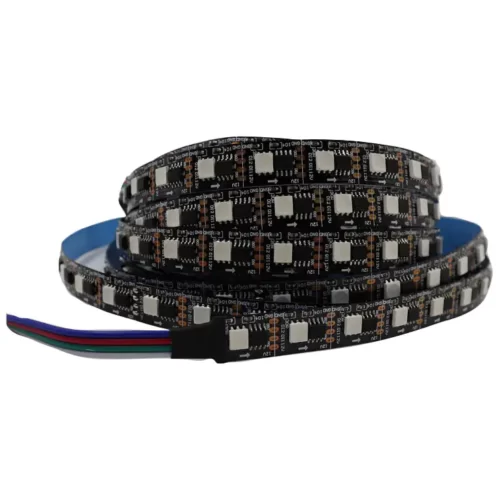What Is Individually Addressable LED Strip
-
by Maisie Ou
- Last updated June 24, 2021
Table of Contents
Addressable LED Strip
Flexible addressable LED strips include RGB individual color change, RGBW individual color change, triple white individual color change, and breakpoint RGB color change. These LED strips are great for landscape lighting, holiday decorative lighting, architectural lighting, channel letters, sign lighting, edge lighting signs, nightclub/KTV and many more applications.
* Use a super bright 5050 SMD LED as a light source, higher brightness, low light decay, long life and very good color consistency.
* Small size, rich color, programmable with IC, with special controller can realize full color change, chasing light, flowing water and many other changes.
* Easy to install.
* Flexible design, suitable for irregular design
Individually addressable LEDs have a tiny microcontroller on each LED, allowing each LED to light up with a unique color and brightness. These bars have a positive voltage line, a ground line and a data line. Whenever data reaches one LED, it is read and passed along the strip to the next LED. The first chip reads the incoming address as LED0, and then executes the instruction of LED0. It also passes the data to the next chip after the counter value increases by 1. In other words, the first LED says “Well, I am LED0, and the next person to receive this message is LED1”, and this message continues to pass along the strip until there are no more LEDS. The important thing you need to know here is that each LED in the bar graph needs to be given a specific command and their specific address.
There are two types of individually addressable RGB LED strips, 5V and 12V, each with some unique advantages. The 12V LED strip is not susceptible to voltage drops, so it can travel a longer distance before the LEDS becomes dim and the color becomes inaccurate. If you plan to run your strip for any significant distance, you may want to inject power at each end of the strip, somewhere in the middle, and if you use a 5V variety. The advantage of using a 5V strip is that you will be able to power your NodeMCU from the same power supply without the need to use a buck converter or some other voltage regulator
Beginners Guide to Individually Addressable RGB LED Strips
First, you need to define how many LEDs you will have in the strip. This refers to the number of controllable nodes, so if you buy an LED strip that has a controller for every 3 LEDs, you need to divide your total number of LEDs by 3. For our WS2812B LED Strip, each LED can be individually controlled, so my 60 LEDs need to be declared as 60 controllable nodes.
Second, you need a suitable LED controller to declare your LED matrix. To do this, you have to enter RGB.
Third, you need to set up our LED strips in void setup by using the controller.add Leds function. You have to tell it the type of LED strip you are using, the data pins they are connected to, the addressing sequence of the red, green, and blue LEDs, the name of the LED matrix, and the number of its LEDs.
When choosing a color, you have several different options. The first is the classic RGB configuration. You can turn on each of the red, green, and blue channels to achieve 255 levels of brightness. Using this method you can generate about 16.8 million unique colors, but the disadvantage is that you need to manipulate 3 variables to change the color.
the order in which the red, green and blue leds are addressed, the name of the led matrix, and the number of LEDS it has.
Shop By Addressable LED Strip Lights Type
Products
-
Tailored Programmable Dream Color APA102 2020 72led 144led 288led Flexible LED Strip
Rated 0 out of 5$0.00 -
5 meters 300 LEDs digital programmable GS8206 GS8208 5050 rgb led strip 12v connectors, IP20 Non-waterproof
Rated 0 out of 5$4.00 – $8.00 -
WS2811 Addressable RGB LED Strip Light 24V 32.8ft 600 LEDs Dream Color Programmable Digital LED Pixel Lights
Rated 0 out of 5$3.00 – $5.00 -
DC24V DMX WiFi/ RF/ APP/ Blue Music Colorful Addressable Controller 2048Pixels
Rated 0 out of 5$13.00 – $50.00 -
Waterproof 7*14- 9*13 Dream color RGB Color changing chasing SMD LED Neon Rope Lighting 24V 33Feet best multi color thin neon light strips for outdoor use
Rated 0 out of 5$5.00
Related Posts
Get in Touch with Us Now!
Do you have questions or feedback? We’d love to hear from you! Just fill out the form below, and our friendly team will respond ASAP.








